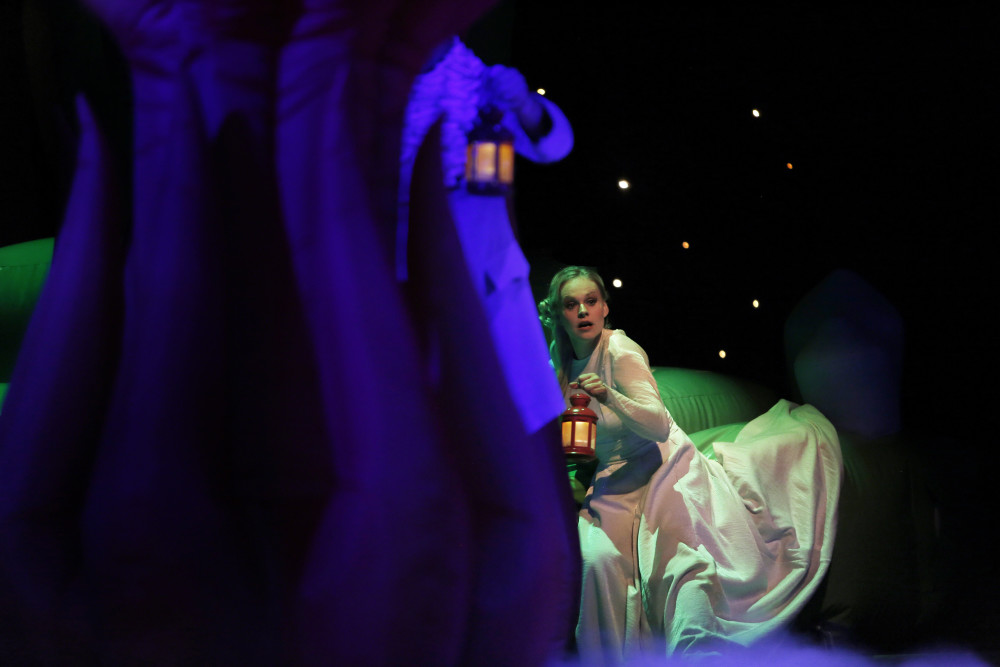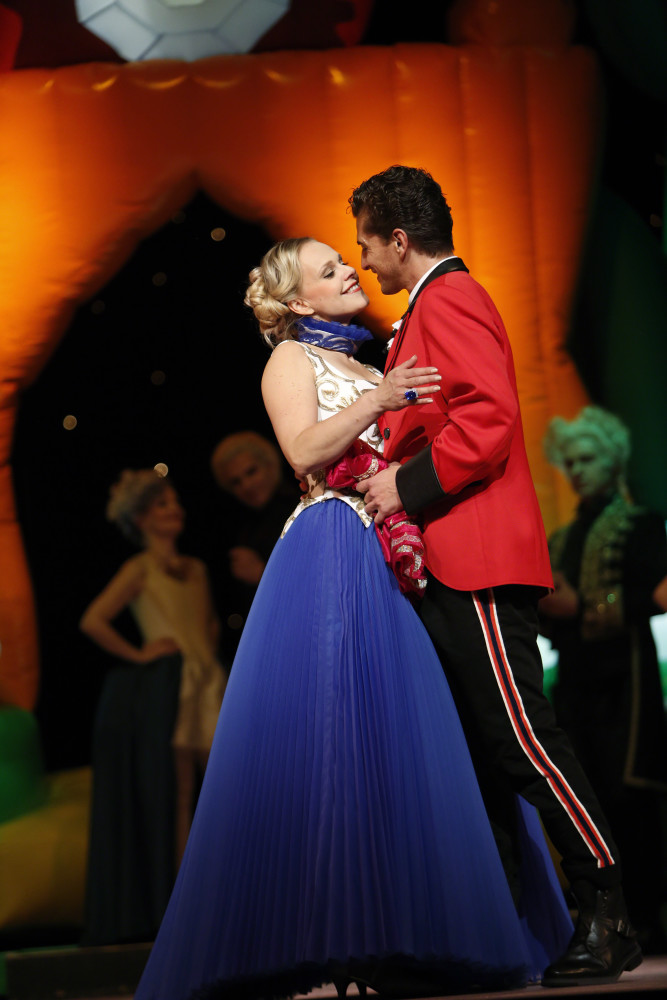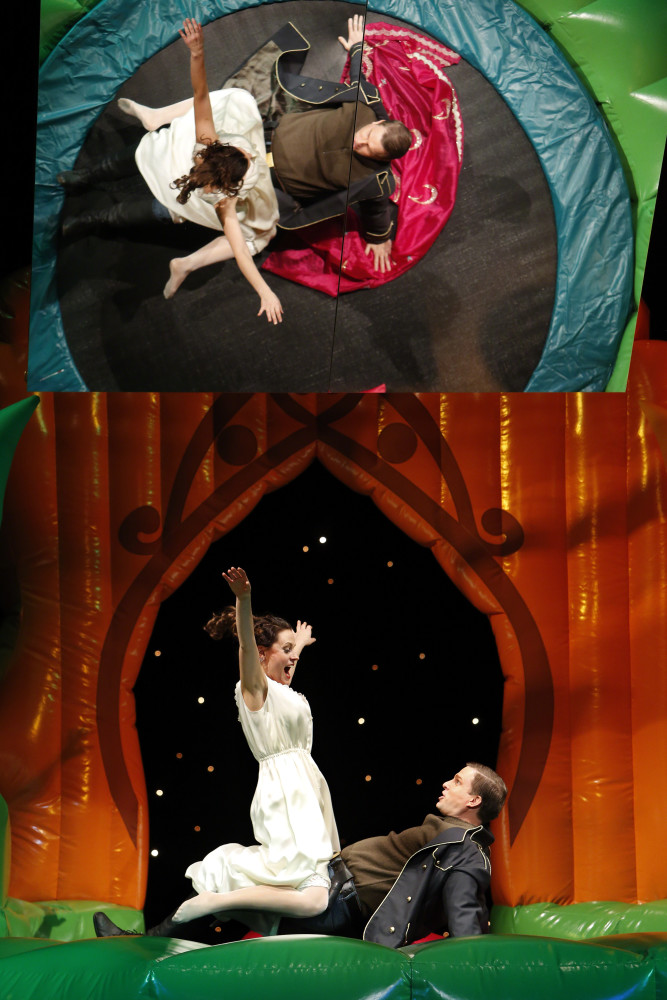Kevin Clarke
Operetta Research Center
14 October, 2017
You might recall that back in the 1990s a renewed interest in so called ‘degenerate’ operettas spread around the world. This trend was kicked off by the Entartete Musik series on Decca (produced by Michael Haas), it included one operetta: Emmerich Kalman’s Die Herzogin von Chicago (1928). Even though this was not the best-ever jazz operetta recording, it was convincing enough to make people realize that there’s more where this came from, and that this ‘more’ was decidedly different from the then-standard Vienna waltz operetta fare. Now, almost 20 years later, another trend can be discerned: a new interest in the non-‘degenerate’ or ‘Aryan’ operettas that followed after 1933. You might say that’s only logical. The latest offering of a show written for the Nazis and premiered in Nazi Germany is Eduard Künneke’s 1935 Die große Sünderin, it’s given a new production by the Musikalische Komödie Leipzig tonight.

Lilli Wünscher as Herzogin Sybilla in Künneke’s “Die große Sünderin,” Oper Leipzig 2017. (Photo: Ida Zenna)
In his new book, Operette im ‘Dritten Reich,’ Matthias Kauffmann devotes a whole chapter to Künneke and especially to Die große Sünderin. It’s the second big Künneke piece written for the ‘cleaned-up’ post-1933 entertainment industry in Germany. The first was the ‘substitute’ operetta Die lockende Flamme in 1933. It was intended to replace Offenbach’s Tales of Hoffmann. And even though it contains some glorious music, it never seriously pushed Hoffmann aside. At least not outside of Germany, and certainly not after 1945.
Künneke’s next attempt was Die große Sünderin written for Berlin’s prestigious Staatsoper Unter den Linden. Like Léhar’s Giuditta (1934) it’s conceived for large opera voices, large orchestra, large everything. The original top stars were Tiana Lemnitz and Helge Rosvaenge, which is a bit like saying Anna Netrebko and Jonas Kaufmann would venture into the realms of heavy-duty operetta today.

Herzogin Sybilla (Lilli Wünscher) and chorus in “Die große Sünderin,” Oper Leipzig 2017. (Photo: Ida Zenna)
There are recordings by both artists of the Sünderin music, their duet “Immerzu singt mein Herz deinem Herzen zu” is a particularly jubilant experience, overwhelming in its vocal splendor and with ecstatically ringing top-notes. Listening to Lemnitz/Rosvaenge makes clear that this was meant to be the total elevation of ‘operetta’ to higher regions, one of the central goals of the Nazi regime. Later singers tackled this duet too, without quite catching Lemnitz’s soprano magnificence, but still offering convincing opera versions.
The other Nazi goal was to create a true ‘German’ operetta. As the Sünderin librettists Katharina Stoll and Hermann Roemmer put it in Blätter der Staatsoper: “The Führer as well as the guardians of art are calling for the new German operetta. What is that? We, the authors of Die große Sünderin, believe such a German operetta should be an operetta written by German artists, for the German people, for a German audience, an operetta with a German story, German characters, German ideals (‘Haltung’) and spirit (‘Wesen’), an operetta full of German lightheartedness (‘Heiterkeit’) and German bounce (‘Beschwingtheit’).”
There sure was a lot of ‘German’ to live up to here, but these were patriotic times. And the Olympic Games were just around the corner, another opportunity to show to superiority of the Germanic ‘master race.’

Herzogin Sybilla (Lilli Wünscher) and Reiteroberst von Schrenk (Adam Sanchez) in “Die große Sünderin,” Oper Leipzig 2017. (Photo: Ida Zenna)
How do these ideological goals translate into a stage show? Here’s the plot outline offered by the Musikalische Komödie for the 2017 production: “Die badische Markgräfin Franziska Sibylla Augusta von Sachsen-Lauenburg, das historische Vorbild zur Titelfigur… , ist eine der schillerndsten Figuren des Barockzeitalters. In die Geschichte eingeschrieben hatte sich die selbstbewusste Aristokratin, die nach dem Ableben ihres Mannes die Geschäfte alleine weiterführte, einerseits durch ihre äußerst repräsentative Hofhaltung, andererseits trat sie auch durch ihre Festigkeit im Glauben in Erscheinung. Seit dem Tod ihres Mannes im Jahre 1707 soll sie bis zu ihrem Tod 1733 in der Öffentlichkeit ausschließlich in Schwarz aufgetreten sein, was die Gerüchteküche über ihr Privatleben natürlich umso mehr anheizte. Sie selbst soll zu ihren Lebzeiten angeordnet haben, auf ihrer Grabplatte folgende Inschrift anzubringen: Betet für die arme Sünderin.“

Franziska Sibylla Augusta von Baden, the original ‘big sinner’ whose life the Künneke show is re-imagining.
In case your English isn’t up to it, it’s a show about Sibylle of Saxe-Lauenburg, Margravine of Baden-Baden. The story is set in the early 18th century in a royal castle. So it’s all rather pompous and grand, but not cheeky like Leo Fall’s Madame Pompadour, and Tiana Lemnitz as Sibylle was as far removed from Fritzi Massary as Pompadour as possible. No kinky asides here, this was – after all – meant to be German Art with a capital A.
Even though Die große Sünderin was to present a new ‘German’ ideal, the other famous number from the show, “Die Ballade vom Leben des Schrenk,” was again intended to replace an Offenbach favorite, his ‘Ballade of Klein Zack.’ It’s a tenor tour de force, and has been popular among later tenors right down to Jonas Kaufmann who included this number in his operetta album.
We don’t know what exactly Künneke’s political ideals were. As Matthias Kauffmann points out there are no surviving documents that give testimony. Which is a situation we know from many other composers of the time; obviously they erased every compromising piece of paper after 1945, many claimed to have been totally apolitical. Nico Dostal was one of those composers supposedly working ‘outside’ of political realities, even if his shows tell a very different story.
Dostal’s Prinzessin Nofretete was seen in Leipzig earlier this year at the Musikalische Komödie. So you could say it’s a mini-series of operettas from Nazi times that the house is presenting in 2017. While the company mentioned the historic frame Nofretete was written in, Die große Sünderin is not introduced with similar background information.
You might ask: is it necessary to always bring up these ‘old’ political stories? Well, it’s not as if Künneke’s biography 1933-45 is common knowledge. Nor will most theater goers today know what this show meant to the Nazis in 1935, and what it might mean today in a region of Germany so heavily dominated by right wing political forces. (Though those can be found more in Dresden, not Leipzig.)

The ballet company of the Musikalische Komödie in “Die große Sünderin” at Oper Leipzig, 2017. (Photo: Ida Zenna)
Still, the ‘Aryan’ operetta series in Leipzig mirrors a similar revival series recently seen in Bad Ischl, where Dostal’s ‘Lebensraum’ operetta Die ungarische Hochzeit was re-presented and recorded for cpo, followed this summer by Fred Raymond’s Saison in Salzburg. All of these shows fall under the ‘substitute’ category. None of the productions offered a serious examination of the political dimensions. Instead, the production teams reduced the shows to banal tunes and silly stories, eliminating the interesting subtext. Because it is too distracting for today’s operetta audiences?
Surely, a student town such as Leipzig, a city known for its political protest culture and the revolutionary spirit of 1989, could count on the intellectual interest of a local audience. It might even lure such an audience to the Musikalische Komödie …. Even though a grand-scale show such as Die große Sünderin belongs onto the stage of the big gilded opera house, not a small scale suburbia institution.

Freifrau Jakobe (Mirjam Neururer) and Leutnant Jürgen von Sommerfeld (Jeffery Krueger) in “Die große Sünderin” at Oper Leipzig, 2017. (Photo: Ida Zenna)
As Matthias Kauffmann points out, the aim of Künneke’s 1935 operetta, and the aim of all true ‘Aryan’ operettas, was to elevate the genre to ‘Singspiel’ levels and to heights defined by Otto Nicolai and Lortzing. (This is how Julius Kapp phrases it in Blätter der Staatsoper, 1935, for the Sünderin premiere.) Ironically, it’s the musical ideal of nearly all cpo operetta recordings too.
It will be interesting to see where this new revival trend will lead to in the future, and how many more such shows we be re-staged before the mother of all ‘real’ German operettas with Singspiel character and true German storyline and music will reenter the repertoire: Heinrich Berté’s Das Dreimäderlhaus. It was the Nazi’s worst nightmare because it contains everything they wanted, only the composer was of Jewish origin. Which sums up the history of “Operetta in the Third Reich” in a nutshell, as Matthias Kauffmann observes.
Who’s got the last laugh now?
For more information on the new Die große Sünderin and performance dates in Leipzig, click here.

Thanks, Kevin, fascinating. Looking forward to seeing it in a few weeks!
Haha! I love SAISON IN SALZBURG! But loathe MASKE IN BLAU. DIE GROSSE SÜNDERIN? Once a decade … but hey at least they’re not doing LUSTIGE WITWE or FLEDERMAUS!!!!!